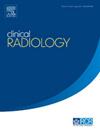Predicting high-intensity focused ultrasound efficacy in adenomyosis treatment based on magnetic resonance (MR) radiomics and clinical-imaging features
IF 2.1
3区 医学
Q2 RADIOLOGY, NUCLEAR MEDICINE & MEDICAL IMAGING
引用次数: 0
Abstract
AIMS
To develop a model predicting high-intensity focused ultrasound (HIFU) efficacy in adenomyosis treatment using enhanced T1WI and T2WI-FS radiomics combined with clinical imaging features.
MATERIALS AND METHODS
The study included 137 adenomyosis patients treated with HIFU from September 2021 to December 2023. Based on nonperfused volume ratio (NPVR), participants were divided into two groups: NPVR < 50% (n=77) and NPVR ≥ 50% (n=60). Patients were randomly split into training and test sets (7:3 ratio). Radiomics features were extracted from enhanced T1WI and T2WI-FS sequences, while clinical imaging features were selected using univariate analysis and binary logistic regression. Logistic regression models were built for radiomics, clinical imaging, and combined data. Model performance was assessed using ROC curves, Delong's test, and calibration curves.
RESULTS
AUCs for the radiomics, clinical-imaging, and combined models in the training set were 0.831, 0.664, and 0.845, respectively, and 0.829, 0.597, and 0.831 in the test set. The combined model outperformed the clinical-imaging model (training p=0.001, test p=0.01) and the radiomics model (training p=0.012, test p=0.032). However, no significant difference was found between the combined and radiomics models (p>0.05). Calibration curves and decision curve analysis confirmed the combined model's accuracy and clinical applicability.
CONCLUSION
A model incorporating clinical-imaging features with T1WI and T2WI-FS radiomics effectively predicts HIFU success in adenomyosis treatment, offering valuable guidance for clinical decision-making.
基于磁共振放射组学和临床影像学特征预测高强度聚焦超声治疗子宫腺肌症的疗效。
目的:建立基于增强T1WI和T2WI-FS放射组学并结合临床影像学特征预测高强度聚焦超声(HIFU)治疗子宫腺肌症疗效的模型。材料和方法:该研究纳入了2021年9月至2023年12月期间接受HIFU治疗的137bb0例患者。根据非灌注容积比(NPVR)将受试者分为NPVR < 50%组(n=77)和NPVR≥50%组(n=60)。患者随机分为训练组和测试组,比例为7:3。从增强的T1WI和T2WI-FS序列中提取放射组学特征,通过单因素分析和二元逻辑回归选择临床影像学特征。建立了放射组学、临床影像学和综合数据的Logistic回归模型。采用ROC曲线、Delong检验和校正曲线评估模型性能。结果:训练集中放射组学模型、临床影像学模型和联合模型的auc分别为0.831、0.664、0.845,测试集中auc分别为0.829、0.597、0.831。联合模型优于临床影像学模型(训练p=0.001,检验p=0.01)和放射组学模型(训练p=0.012,检验p=0.032)。然而,联合模型与放射组学模型之间无显著差异(p < 0.05)。校正曲线和决策曲线分析证实了联合模型的准确性和临床适用性。结论:将临床影像学特征与T1WI和T2WI-FS放射组学相结合的模型可有效预测HIFU治疗子宫腺肌症的成功率,为临床决策提供有价值的指导。
本文章由计算机程序翻译,如有差异,请以英文原文为准。
求助全文
约1分钟内获得全文
求助全文
来源期刊

Clinical radiology
医学-核医学
CiteScore
4.70
自引率
3.80%
发文量
528
审稿时长
76 days
期刊介绍:
Clinical Radiology is published by Elsevier on behalf of The Royal College of Radiologists. Clinical Radiology is an International Journal bringing you original research, editorials and review articles on all aspects of diagnostic imaging, including:
• Computed tomography
• Magnetic resonance imaging
• Ultrasonography
• Digital radiology
• Interventional radiology
• Radiography
• Nuclear medicine
Papers on radiological protection, quality assurance, audit in radiology and matters relating to radiological training and education are also included. In addition, each issue contains correspondence, book reviews and notices of forthcoming events.
 求助内容:
求助内容: 应助结果提醒方式:
应助结果提醒方式:


